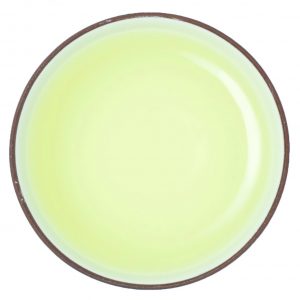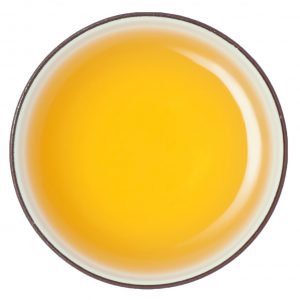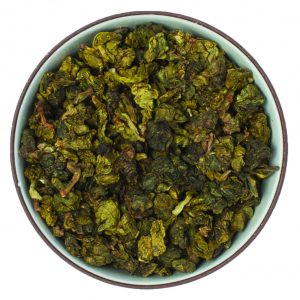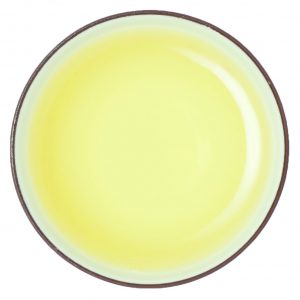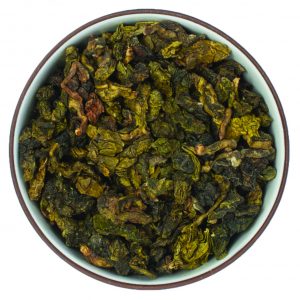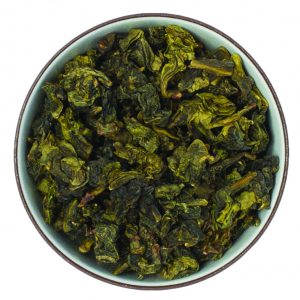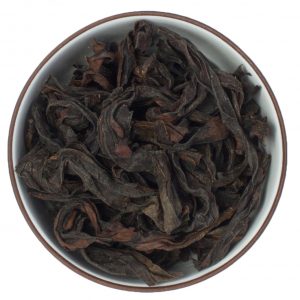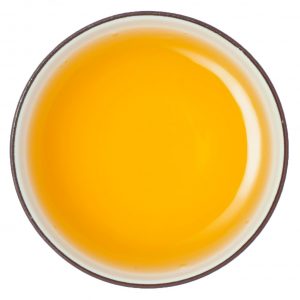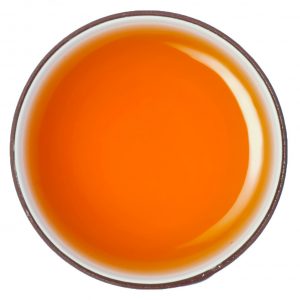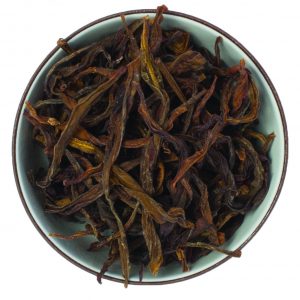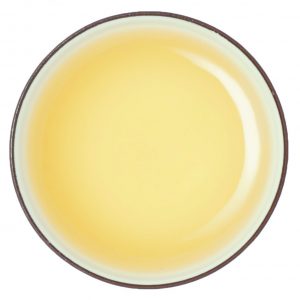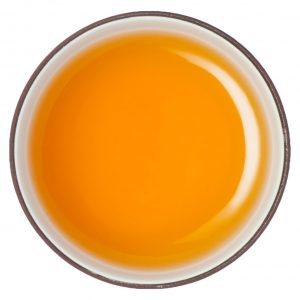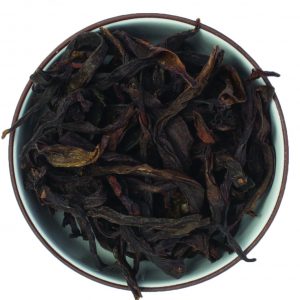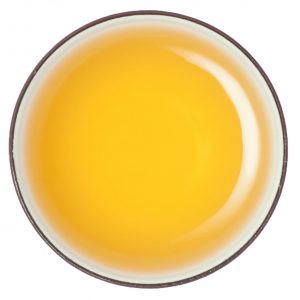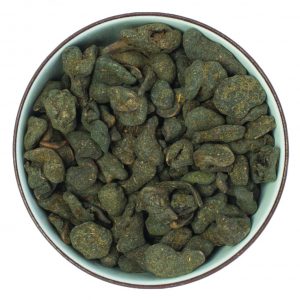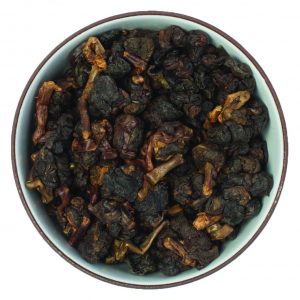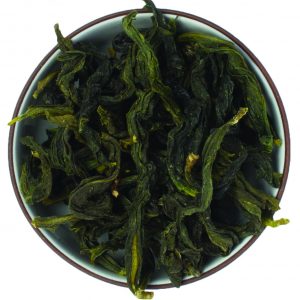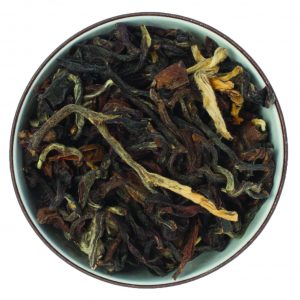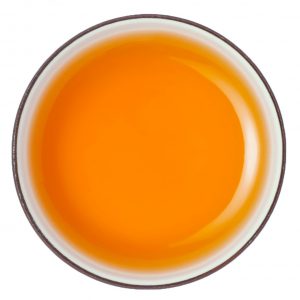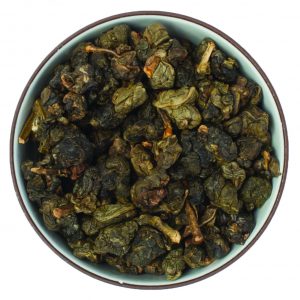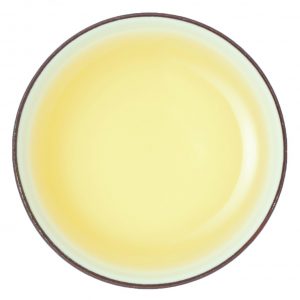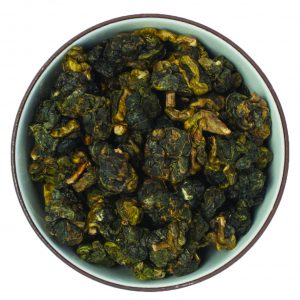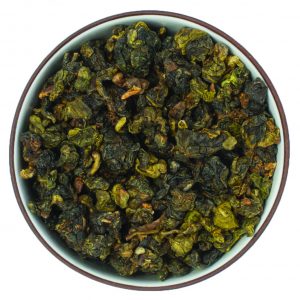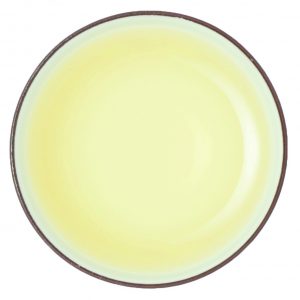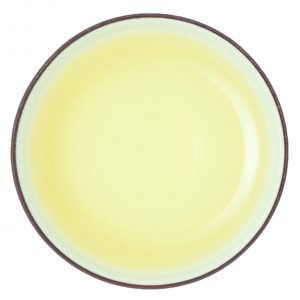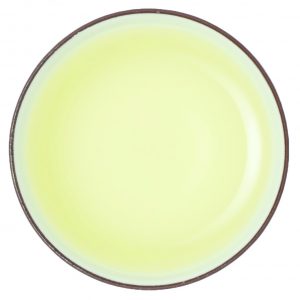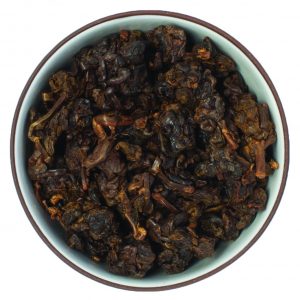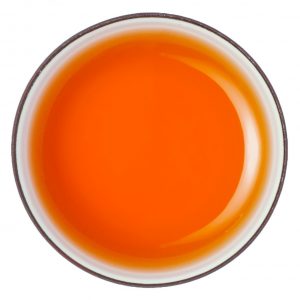This content is an excerpt from Tony’s book, Tea: A User’s Guide. For more information on the book, please visit the book’s web page.
The word Wulong translates to black dragon. The proper pinyin is wūlóng (乌龙), but oolong (a haphazard transliteration) has become the most popular spelling in the West.
Wulong leaves are semi-oxidized. This means that during production, oxidation is initiated, controlled and halted at some point before the leaves are considered fully oxidized. This is why you will often hear wulong described as being in between green tea and black tea. However, as with many things in the world of tea, it is more complicated than this.
A distinct step in the processing of traditional wulong tea is the bruising step (also called rattling or shaking). The leaves are shaken, lightly rolled or tumbled until the edges bruise. This bruising causes cellular damage and initiates the oxidation process. Bruising as a processing step is an iterative process wherein the leaves are bruised and allowed to wither and oxidize slowly.
The process happens repeatedly until they have reached a desired level of oxidation. The leaves are then heated (fixed) to stop oxidation and are shaped and dried. Let’s take a look at each step in a little more detail, beginning with the harvest.
Plucking
When plucking leaves for wulong production, tea pickers wait until the buds on the tea plant have opened and thickened. Depending on the intended shape of the final product, pickers will pluck anywhere from three to five leaves at a time. The reason for plucking older, thicker leaves is that they are more likely to endure the intense kneading and shaping required by the wulong production process.
Withering
Wulongs are typically withered in the sun or in diffused light under movable shades outdoors. Once the leaves are bruised, the withering process continues, often indoors. The withering process varies from producer to producer, but the goals of withering are the same: to prepare the leaves for further processing by making them flaccid. The withered leaves allow fragrance to develop.
Bruising / Oxidation
The distinct processing step that makes a wulong a wulong is bruising. The goal of bruising the leaves is to initiate oxidation. To do so, depending on the type of tea being made and the person making it, the leaves will be tumbled, shaken, or even lightly rolled (as is the case for many new non-traditional wulongs). When the leaves are bruised, the cell walls within the bruised portion of the leaves are broken, initiating oxidation. The leaves are then left to wither and oxidize before being further bruised. This iterative process continues until the desired level of oxidation is reached by the tea maker. Wulongs are often referred to as semi-oxidized teas and as such can be made at a wide range of oxidation levels. The greenest wulongs are oxidized to around 5–10%, while darker style wulongs are almost oxidized to black tea levels, around 80–90%.
Fixing
Once the desired level of oxidation is reached by repeatedly bruising the leaves and allowing them to wither, they are heated to prevent any further oxidation. Most wulongs are fixed by hot air in heated tumblers.
Shaping
Traditionally, wulongs are processed into two different shapes: half-ball shape (also commonly referred to as partial-ball shape) and strip shape (also commonly referred to as stripe shape). Half-ball style wulongs are shaped using an iterative process called cloth-wrapped kneading where tea leaves are wrapped in cloth and kneaded. When this is done, the leaves clump together and form a tight ball. The leaf-mass is gently broken apart and then kneaded in cloth again. This process can go on for hours.
In most commercial applications, cloth-wrapped kneading is accomplished by a machine. However, small-scale artisan tea producers still knead the tea by hand (or even with their feet). Strip shaped wulongs are rolled by hand or by a machine without the use of cloth. They are twisted length-wise rather than rolled into a ball. During rolling, the amount of pressure exerted on the leaves is carefully monitored so that the leaves are not ripped apart.
Presentation of the finished tea is important to the tea producer, and a tea with a large percentage of stems is assumed to be a tea of lesser quality. Stems are picked off of finished tea leaves by hand or by machine before being packed and shipped. Sometimes stems are left on the finished leaves when sold. After all, this is a very laborious process, and tea is sold by weight.
Drying and Roasting
Regardless of the shape of the leaves, once they are rolled or kneaded the mass of leaves is broken apart so that the leaves can be easily dried. In commercial production settings, wulong is dried in large ovens powered by electricity or gas. Smaller artisan production lines will use baskets over hot coals to slowly dry the leaves. This is often called firing or the first drying. Wulongs will often go through a second drying, also known as roasting. Roasting is done to mellow the tea’s flavor and add to its complexity. At times, errors in processing can be hidden by a strong roasting step.
Wulong Teas of China
About 11% of tea grown in China is wulong tea. The majority of Chinese wulong production comes from the mountainous regions of Fujian Province. Fujian is home to the Anxi Tie Guan Yin and Wu Yi Yan Cha styles. The mountains of Wu Yi are the birthplace of wulong production, and the teas from that region are a testament to wulong’s heritage.
Minnan Wulongs
Minnan wulongs refer to those produced South of the Min [River] in Fujian province. A famous growing region lies there, Anxi county. Anxi county is known primarily for the production of Tie Guan Yin, Huang Jin Gui, Ben Shan, Mao Xie, and the hybrid Jin Guan Yin. Anxi wulongs are difficult to tell apart by appearance alone, as they are usually produced in a similar half-ball style shape. Each one can be produced with varying levels of oxidation and roast. Oxidation and roast levels are altered slightly for each tea to preserve the qualities distinct to each cultivar and harvest. In general they are all processed in the same manner:
- withered in the sun
- tumbled to bruise the edges of the leaves
- withered (then bruised again, sometimes 20–30 times)
- fixed
- kneaded while wrapped in cloth (many times)
- dried
Finished Anxi wulongs are almost always made up of single leaves that were broken off the stem by hand after drying.
Anxi Tie Guan Yin (安溪 铁观音, ān xī tiĕ guān yīn) Anxi Iron Goddess of Mercy
This tea style is produced in Fujian Province’s Anxi county and is arguably the most famous wulong. Tie Guan Yin is made from the leaves of a cultivar with the same name, ‘Tie Guan Yin.’ Traditional versions of this tea are heavily roasted, but it is most commonly found in a green, unroasted state today. Tie Guan Yin is one of China’s top ten famous teas; it is known for its floral fragrance and hou yun (喉韵) meaning throat resonance or aftertaste.
Anxi Huang Jin Gui (安溪 黄金桂, ān xī huáng jīn guì) Anxi Golden Cassia or Golden Osmanthus
This tea style is produced in Fujian Province’s Anxi county and is very similar to Tie Guan Yin in appearance
except for its yellow color. The yellowish color of the leaves is a characteristic of the ‘Huang Jin Gui’ cultivar. Huang Jin Gui is the earliest to flush of all the Anxi cultivars.
Anxi Ben Shan (安溪 本山, ān xī bĕn shān) Anxi Original Mountain
This tea style is produced in Fujian Province’s Anxi county. Ben Shan is also very similar in appearance to Tie Guan Yin, the main difference being the cultivar this tea is made from, ‘Ben Shan.’
Anxi Mao Xie (安溪 毛蟹, ān xī máo xiè) Anxi Hairy Crab
This style of tea is produced in Fujian Province’s Anxi county. Mao Xie is very similar in appearance to Tie Guan Yin, the distinguishing feature being the large amount of hairs on the leaves. The cultivar this tea is made from, ‘Mao Xie,’ is known to have hairy crab-like leaves.
Anxi Jin Guan Yin (安溪 金观音, ān xī jīn guān yīn) Anxi Jin Guan Yin
Jin Guan Yin is a hybrid cultivar made from Tie Guan Yin and Huang Jin Gui. It is also a popular cultivar for the production of Wu Yi Yan Cha.
Minbei Wulongs
Minbei, or North of Min [River] refers to wulongs growing north of the Min river in Fujian province. The Wu Yi Yan Chas fall into this region. Yan Cha (岩茶, yán chá) means rock tea; it is a name given to the teas of Wu Yi Shan because the tea plants there are known to thrive in the rocky soils of the area. This unique terroir is responsible for the “rock taste” that gives these teas their fame. Known as Yan Yun (岩韵 , yán yùn) literally rock rhyme, this is a way of describing the distinctive aftertaste yan cha is famous for.
All of the gardens in the Wu Yi area were propagated from four to six “mother trees” that still exist today and are a spectacle in the protected area of Wu Yi Shan. The further away from the protected Wu Yi area the plants are growing, the less sought after teas made from them are. There is actually a widely accepted nomenclature for this:
- Zheng Yan (正岩, zhēng yán), literally center rock teas, are grown inside the Wu Yi protected area.
- Ban Yan (半岩, bàn yán), literally half rock teas, are grown near the edges of the protected area.
- Zhou Cha (洲茶, zhōu chá) or river bank teas are grown well outside of the protected Wu Yi area.
All Wu Yi teas are produced in nearly the same fashion. They are withered, tumbled, oxidized, fixed, rolled, dried and roasted. Wu Yi teas are formed into their distinctive strip shape by rolling the leaves length-wise on a rolling table.
Four Famous Wu Yi Teas
These teas are made from plants that have been propagated from the four famous bushes of Wu Yi Shan. They are often called Si Da Ming Cong (四大名丛) teas, meaning Four Great Bushes.
Wu Yi Da Hong Pao (武夷 大红袍, wŭ yí dà hóng páo) Wu Yi Big Red Robe
This style of tea is one of the two wulongs (Tie Guan Yin is the other) that make it to the list of top ten famous Chinese teas (see appendix). Big Red Robe is the most famous and widely produced of the Si Da Ming Cong teas. There is no specific Da Hong Pao cultivar; either Qi Dan (奇丹) or Bei Dou (北斗) are used or a blend is made from many different cultivars with the goal of creating a tea that best exemplifies Yan Yun (岩韵) or rock rhyme, the distinctive aftertaste of Wu Yi Yan Chas.
Wu Yi Shui Jin Gui (武夷 水金龟, wŭ yí shuǐ jīn guī) Wu Yi Golden Water Turtle
This style of tea is a Wu Yi Si Da Ming Cong tea made from the ‘Shui Jin Gui’ cultivar.
Wu Yi Shui Jin Gui dry
Wu Yi Tie Luo Han (武夷 铁罗漢, wŭ yí tiě luó hàn) Wu Yi Iron Monk Arhat
This style of tea is the oldest of the Wu Yi Si Da Ming Cong tea made from the ‘Tie Luo Han’ cultivar.
Wu Yi Bai Ji Guan (武夷 白鸡冠, wŭ yí bái jī guān) Wu Yi White Cockscomb
This is known in China as a Wu Yi Si Da Ming Cong style of tea. The leaves from the ‘Bai Ji Guan’ cultivar appear white-ish, hence the name. The finished tea is made up of long, curled yellow-brown strips.
Other Wu Yi Cultivars
These cultivars are not included in the Si Da Ming Cong (四大名丛) teas and are sometimes called Qi Zhong (奇种)—literally, the weird kinds.
Wu Yi Rou Gui (武夷 肉桂, wŭ yí ròu guì) Wu Yi Cassia or Wu Yi Cinnamon
This style of Wu Yi tea is named after the distinctive cinnamon notes in tea steeped from teas made from the ‘Ro Gui’ cultivar.
Wu Yi Shui Xian (武夷 水仙, wŭ yí shuǐ xiān) Wu Yi Narcissus
This style of Wu Yi tea is known for notes of honey in the tea liquor made from its leaves. The ‘Shui Xian’ cultivar is often grown elsewhere outside of the Wu Yi area, but it is usually still processed like a Wu Yi wulong.
Wulongs of Guangdong Province
Feng Huang Dan Cong
(凤凰单丛, fèng huáng dān cōng)
Feng Huang single bush or single trunk
Dan Cong refers to a style of strip-shaped wulong production wherein leaves are plucked and processed from single trees. The original plants were propagated by seed over 700 years ago in the Phoenix Mountain (Feng Huang Shan) region. They have been harvested and processed individually since, hence the name Dan Cong or single bush. The tea producers noticed that each plant produced tea that tasted different. Dan Cong teas are a perfect example of selective breeding, as the plants were named after the fragrance of the finished teas they produced and have since been asexually cloned for commercial production.
Authentic Dan Cong teas must be grown within the Phoenix Mountain area in Guangdong’s Chao An County and must come from one of the famous cultivars. It is thought that all of the Dan Cong cultivars are descendants of the ‘Shui Xian’ cultivar. Here are some of the well-known cultivars (note that xiang ‘香’ means fragrance):
- Gui Hua Xiang (桂花香, guì huā xiāng) Osmanthus Fragrance
- Huang Zhi Xiang (黄栀香, huáng zhī xiāng) Gardenia Fragrance
- Jiang Hua Xiang (姜花香, jiāng huā xiāng) Ginger Flower Fragrance
- Mi Lan Xiang (米蘭香, mĭ lán xiāng) Honey Orchid Fragrance
- Rou Gui Xiang (肉桂香, ròu guì xiāng) Cinnamon Fragrance
- Xing Ren Xiang (杏仁香, xìng rén xiāng) Almond Fragrance
- Ya Shi Xiang (鸭屎香, yā shĭ xiāng) Duck Shit Fragrance
- You Hua Xiang (柚花香, yòu huā xiāng) Pomelo Flower Fragrance
- Yu Lan Xiang (玉兰香, yù lán xiāng) Magnolia Flower Fragrance
- Zhi Lan Xiang (芝蘭香, zhī lán xiāng) Orchid Fragrance
Other Chinese Wulongs
Lan Gui Ren (兰贵人, lán guì rén) Lady Orchid
This tea is also known as Ginseng Wulong because the tea is processed with powdered American Ginseng root and licorice root powder and then rolled into tiny solid-looking pellets.
Lan Gui Ren dry leaves (13.9 g) and liquor.
Wulong Teas of Taiwan
Formerly known as Formosa, Taiwan is a small island that lies on the Tropic of Cancer just off the east coast of Fujian province. Taiwan occupies an area just 0.4% the size of mainland China. Given its proximity to Fujian province, Taiwan is famous for its production of wulong tea; 90% of tea produced there is wulong.4 The island is able to produce a myriad of wulong styles due to the micro-climates of the different growing regions, a product of the vast differences in elevation across the island. Because Pinyin only became the standard method of romanization in Taiwan in 2009, you will likely encounter many Wade-Giles spellings of tea terms when purchasing Taiwan wulongs.
Nantou Dong Ding (南投 冻顶, nán tóu dòng dĭng) Nantou Frozen Summit
Arguably the most famous of the half-ball-style Taiwan wulongs hails from Nantou County in central Taiwan from the areas surrounding Dong Ding mountain. Dong Ding wulong is typically produced using leaves from the ‘Qing Xin’ cultivar of tea plant. Fresh leaves destined to become Dong Ding wulong are withered in the sun and tumbled to bruise the edges of the leaves. Next an iterative process begins wherein the leaves are withered, then bruised further many times. Once the desired amount of oxidation has been reached, the leaves are fixed. Once fixed, the leaves are kneaded while wrapped in cloth. The leaf mass forms a tight ball that is then carefully broken apart and kneaded again. This step is responsible for forming the half-ball shape of these wulongs. Once the desired shape is achieved, the leaves are dried. Dong Ding wulongs are typically produced with lower amounts of roast and oxidation.
Muzha Tie Guan Yin (木栅 铁观音, mù zhà tiĕ guān yīn) Muzha Iron Goddess of Mercy
Muzha Tie Guan Yin is Taiwan’s version of Fujian’s half-ball style Tie Guan Yin. Traditionally, this tea was heavily roasted before being sold, but today the trend seems to be that wulongs sell better when roasted very little, or not at all. Muzha Tie Guan Yin is a half ball-style wulong produced from the ‘Tie Guan Yin’ cultivar using the cloth-wrapped kneading process.
Wen Shan Bao Zhong (文山 包种, wén shān bāo zhŏng) Wen Shan Wrapped Kind
Bao Zhong is a strip-style wulong from the Wen Shan area of Northern Taiwan. Compared to other Taiwan wulongs, Bao Zhong is typically the least oxidized wulong style. Its oxidation levels are usually well under 20%. The name “wrapped kind” comes from an old packaging method where Bao Zhong leaves were packaged in folded paper wrapping for selling. To make Bao Zhong, leaves from the ‘Qing Xin’ cultivar are withered in the sun, withered indoors, lightly tossed to initiate oxidation, rolled and dried.
Dong Fang Mei Ren (东方美人, dōng fāng mĕi rén) Oriental Beauty
This style of tea is also known as Bai Hao or White Tip wulong due to the use of buds in the finished tea. Dong Fang Mei Ren hails from the Hsinchu City area of Northern Taiwan and is produced from the ‘Qing Xin Da Mao’ cultivar. This strip-shaped wulong is heavily withered and heavily oxidized to 70–80%. The oxidation process starts while the leaves are still attached to the plant in the field once the unsprayed leaves are bitten by jassids and other insects. The plant in turn creates more polyphenols to inhibit further insect attack.
Gao Shan (高山, gāo shān) High Mountain
Literally High Mountain, Gao Shan is a designation given to any wulong grown at an elevation higher than 1000 m. The most famous growing regions above 1000 m are Ali Shan, Shan Lin Xi, Li Shan and Da Yu Ling. Da Yu Ling is the highest growing mountain at 2400 m. Teas grown in these regions are usually less oxidized and unroasted in order to show off the special qualities that these high mountain teas possess. Qing Xin, Jin Xuan, Cuiyu and Si Ji Chun are the most popular cultivars of tea plant cultivated in the high mountain regions.
Gao Shan (Jin Xuan from Alishan) dry leaves (13.9 g) and liquor.
Famous Taiwan Wulong Cultivars
These cultivars are sometimes sold by name only; other times they are grown above 1000 m and called Gao Shan. The reason I list them out here is that you will often see them called out by name.
Jin Xuan (金萱, jīn xuān) Golden Lily
Jin Xuan is a famous cultivar from Taiwan known for producing a creamy mouthfeel and milk-like aroma or nai xiang (奶香) when steeped. Many “milk wulongs” on the market will contain artificial flavorings, but true Jin Xuan possesses nai xiang without any adulterants. This cultivar was created by the Tea Research and Extension Station and is also known as TRES #12.
Si Ji Chun (四季春, sì jì chūn) Four Seasons of Spring
As its name suggests, this cultivar produces a fragrant spring-like crop year round. Because of this, it has also been given the nickname evergreen.
Cuiyu (翠玉. cuì yù) Green Jade
This cultivar is popular for making lightly oxidized or jade wulongs. This cultivar was created by the Tea Research and Extension Station and is also known as TRES #13.
Qing Xin (青心, qīng xīn) Green Heart
This cultivar is also called Ruan Zhi (軟枝). Ruan Zhi means soft stem, and it is often transliterated as Luan Ze.
Other Taiwan Wulongs
Gui Fei (贵妃, guì fēi) Precious Concubine
Gui Fei is a style of tea that is processed similarly to Dong Feng Meiren except that it is rolled into a half-ball shape instead of strip shape. Just like Dong Feng Mei Ren, it is grown pesticide-free and is allowed to be bitten by jassids. Gui Fei is often highly oxidized and lightly roasted.
Jia Xie Long Cha (佳叶龙茶, jiā xié lóng chá) GABA Tea
This style of tea is exposed to nitrogen during oxidation. The presence of nitrogen and absence of oxygen during processing converts glutamic acid to gamma-Aminobutyric acid, or GABA. GABA tea can really be produced as any type of oxidized tea, but it is most often produced as wulong. GABA has been touted for its health benefits for years, but recent research suggests that GABA is unable to cross the blood-brain barrier, thus discounting many of the health claims made by GABA producers.


